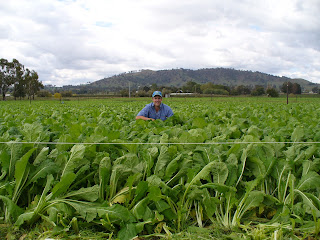Autumn sown brassica and ryegrass provides a quick option for increasing early DM production, whilst reducing feed costs ($/tonne).
Sown at 2 kg/ha with normal rates of ryegrass in late Februaury to mid April, commonly Crusader Italian ryegrass, the hybrid brassica and ryegrass blend can produce considerable extra DM production for an increased sowing cost of approx $20/ha. The extra growth at first grazing provided by the brassica and ryegrass blend when compared with straight ryegrass can be anywhere between 1,500 - 3,000 kg DM/ha, which depends on soil temperature and moisture.
Autumn sown Hunter forage brassica sown at 2 kg/ha with 20 kg/ha Crusader Italian ryegrass. The paddock is ready for grazing 6-8 weeks from sowing.
Aim to sow no more than 6-7 ha/100 cows to Hunter forage brassica and Crusader Italian ryegrass otherwise shading of the ryegrass will occur effecting ryegrass establishment and subsequent grazings. Grazing should commence 5-6 weeks from emergence. Hunter forage brassica's large leaves and prostrate growth can cause shading. If looking for more area sown to brassica and ryegrass sow Winfred forage brassica and Crusader Italian ryegrass for later maturity or stagger sowing date, aiming to sow Hunter 3 to 4 weeks from first sowing. The later sowing will most always result in reduced brassica growth due to lower soil tempertures. Once you reach late April - early May there is little to no gain from sowing brassica with ryegrass.
Winfred forage brassica and Crusader Italian ryegrass autumn sown in March at Cobram in the Goulburn Valley. Photos show pre-grazing mass. The Winfred and Crusader was able to produce an extra 2,110 kg DM/ha when compared with straight Italian ryegrass sown the same day.
This year we will have trials in Gippsland and Goulburn Valley looking at the extra DM produced from Autumn sown Hunter and ryegrass when compared with ryegrass. Stay in touch for the results!








